
This is Conwy from the vantage point of its town walls, on a drizzly morning in early autumn. It has a population of 14000, which doesn’t really qualify it as small, but the area inside the walls is quite compact, so it feels much smaller than it should.

Most visitors to this part of north Wales stay in Llandudno, which has a lot more hotels, places to eat and so on. But I’m glad I chose Conwy (mostly unwittingly); it has a charm most of the other towns I stayed at lacked.

Admittedly, a big part of this charm was due to Conwy being home to a massive castle!
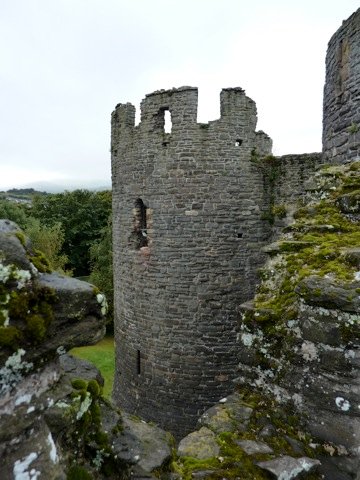
My fifth castle of the trip and I still wasn’t bored of them yet.

Conwy Castle was built for Edward I between 1283 and 1289. It was the most expensive of all his Welsh castles. A wise investment, as it turned out, since Edward himself survived a siege within its walls over Christmas 1295.

Why did Edward need such a strong castle here? Guarding the crossing of the River Conwy was the proximate reason. To keep the Welsh down was the ultimate reason. At first, Welsh people weren’t even allowed inside the walls of the town.
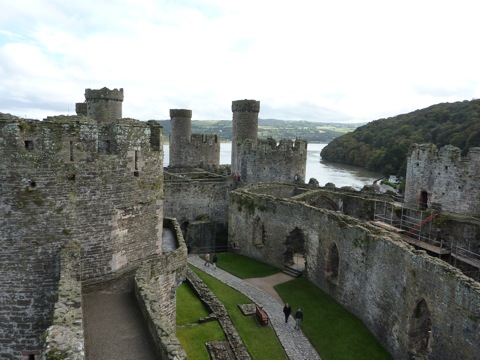
It’s easy to think of castles in terms of assaults and sieges, but these were of course rare events. Aside from the siege in 1295, the only other times Conwy Castle saw action was when it was captured by cousins of the Prince of Wales, Owain Glyndwr, in 1401, and then by Yorkists during the War of the Roses. Finally, it was taken by Parliamentary forces in 1646, one of the last Royalist castles to hold out.
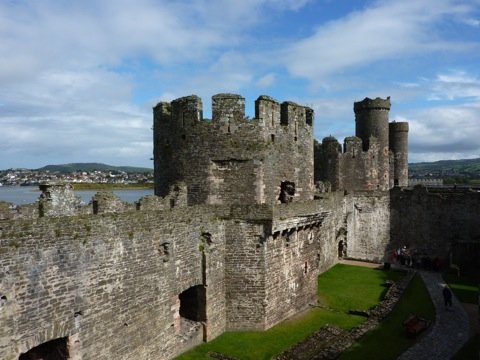
Much of the time, these big castles seem to have been surprisingly poorly maintained, with crumbling walls and rotten stores. Their power was often just theoretical. In 1401, it was captured while its garrison was at prayer (it being Good Friday). Only two men were guarding the gates, and these were killed by one of the rebels who posed as a carpenter. So much for those thick walls.
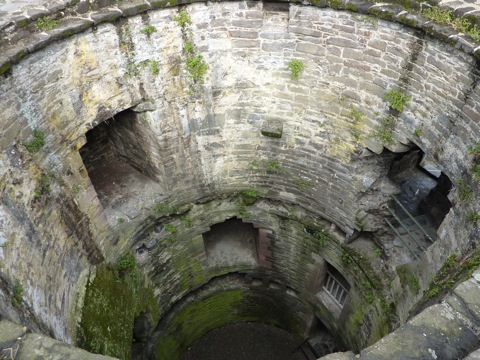
Having said that, the band which took the castle held it against the English for three months. Rhys and Gwilym ap Tudur had taken part in Glyndwr’s rebellion, but weren’t pardoned afterwards, hence the crazy plan to capture Conwy Castle. Because nothing says ‘sorry for that rebellion’ like another rebellion! But it worked: they got their pardon.
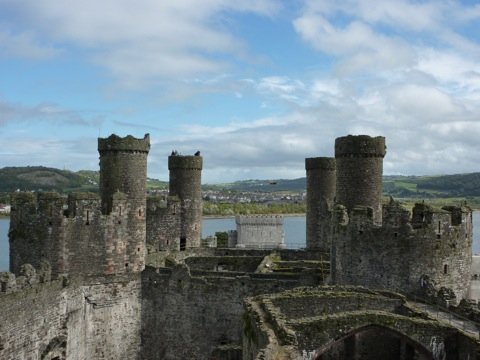
The castle survived the Civil War, but in 1665 the castle’s owner (the Crown had sold it in 1627) pulled bits of it down to sell, particularly the lead from the roofs. (That white tower in the centre is not actually part of the castle, it’s the railway bridge; see below.)
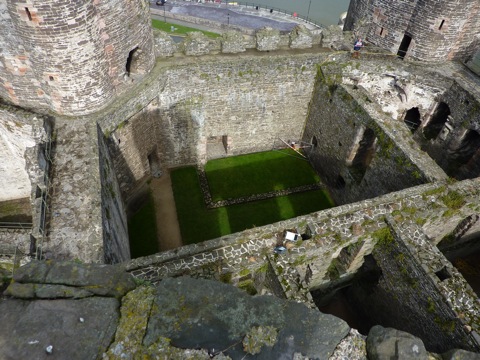
Still, as you can see here, the internal arrangement of the castle is surprisingly well-preserved. This area is the inner ward, which is where royal visitors would have stayed. A bit cramped perhaps, but quieter and more private than the outer ward, where most of the castle’s daily business was conducted.
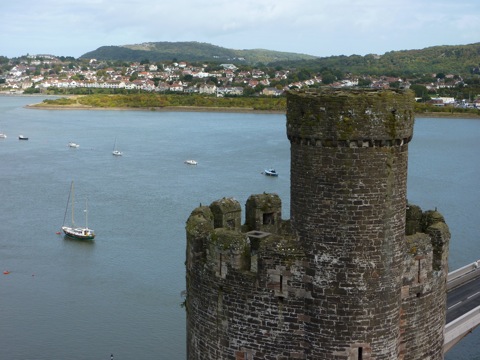
The Chapel Tower, with a fine view of the estuary beyond.

(Okay, this is a finer view. The headland is the Great Orme, which overshadows Llandudno.)

The unmartial-sounding Bakehouse Tower.

A slightly wider shot, showing the Great Hall, with another (probable) chapel at the near end. It has an odd curved shaped, dictated by the shape of the outcrop of rock the castle is built on.

Inside the Great Hall.

In this photo, you can just make out a couple of finials, pieces of stonework which jut up into the air — on the merlons closest to the turret, either side of the crenel. (Look them up!) You might think they were designed to make make it harder for any enemy to climb over (well, I did), but apparently they have no function other than decoration. But does this mean the motivation was purely aesthetic, or were they meant to impress naive onlookers (like me)?

Compared with the castles at Cardiff and Caerphilly, Conwy Castle has been restored with a light touch. Aside from a wall here and there, and the roofs of some towers, it’s more conservation than rebuilding. It doesn’t make Conwy Castle any more ‘authentic’ than they are, but it does feel more ‘natural’, in the sense that the ravages of time haven’t been reversed, just slowed down.

It’s a fine castle indeed, and I’d certainly consider it for my next siege.

The three bridges of Conway. In the centre is Thomas Telford’s historic suspension bridge, built in 1826. On the right is Robert Stephenson’s historic tubular bridge, built 1848. On the left is a twentieth century bridge nobody cares about (yet?) Aside from their technological innovations, the striking feature of both Telford’s and Stephenson’s bridges is the way they’ve added turrets and towers so that they are not completely jarring when set against the castle (which they literally are; I took this photo from the northern battlements). It’s an interesting contrast to York in the early railway age. There the town walls were nearly torn down wholesale, the better to let traffic into the city; harmonisation with the decor of a bygone age was not on the agenda.
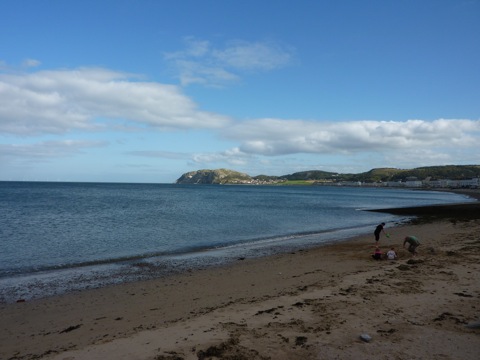
After spending the morning in the castle (and after a very tasty rarebit for lunch in the adjacent cafe), I headed up to Llandudno for the afternoon. Llandudno was one of the great Victorian seaside resorts. As an Australian, I probably should say something disparaging about British beaches here, but that would be a tad hypocritical since I haven’t been to an Australian beach for about five years!
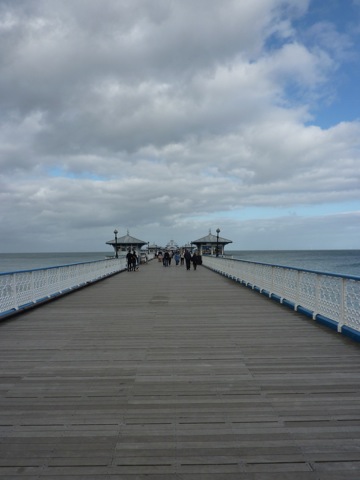
A seaside resort needs an amusement pier. With tacky amusements (not shown).
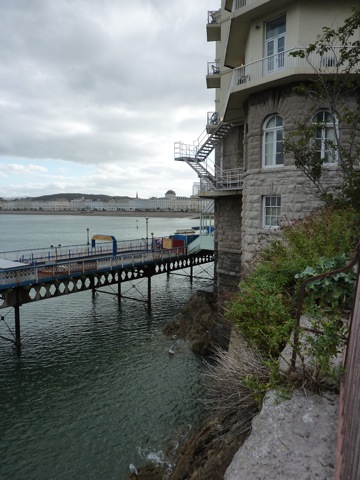
A seaside resort also needs hotels. This one takes ‘seaside’ to an extreme, though.

I have to admit that I didn’t really take to Llandudno. There’s not really a lot to see (and, to be fair, the summer season was over). But there was one attraction which was one of the highlights of the whole trip, the Great Orme Mines.

I had no idea this place existed! It’s a prehistoric copper mine, which was first worked around 3,500 years ago, and may have lasted until Roman times. The copper was smelted with tin to make bronze, which as you might expect was a valuable commodity in the Bronze Age.

It’s not small, either. Tunnels run for kilometres underground, reaching a depth of at least 70 metres. And the archaeologists working the site (some of whom run the small museum attached) think there’s much more below that. See Andrew Lewis’ M.Phil. thesis for more information.

The Great Orme Mines deserve to be much more widely known. If you’re at all claustrophobic I wouldn’t recommend it, but otherwise it’s a fascinating experience — my photos don’t do it justice — and visiting it makes it that much harder to underestimate the capabilities of our ancestors.
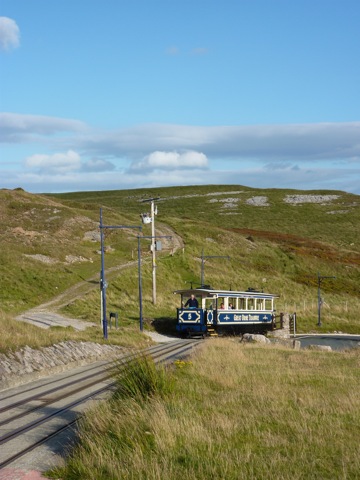
Another thing I liked about Llandudno was the cable tram, which took me up the Great Orme. Almost like a W Class back home.
![]() This work is licensed under a Creative Commons Attribution-NonCommercial-NoDerivatives 4.0 International License.
Permissions beyond the scope of this license may be available at http://airminded.org/copyright/.
This work is licensed under a Creative Commons Attribution-NonCommercial-NoDerivatives 4.0 International License.
Permissions beyond the scope of this license may be available at http://airminded.org/copyright/.



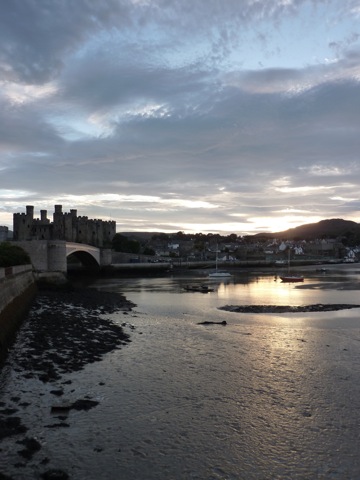

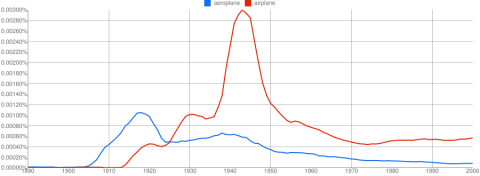
Curious to know whether you are related to my family of Holmans who settled in North Wales (the surname sometimes ‘Homan’) John Holman had a shop in Llandudno in the early 1900s, selling among other things pottery and souvenir photos. Do you have any Somerset connections, which is where my family come from originally?
Love the Conway photos,by the way – you have lit up the castle beautifully – so often it looks gloomy in photos!
Thanks — I was lucky with the weather the whole trip (that morning was the only rain I had) so there was plenty of light to play with!
I don’t think we are related (at least not closely). My family emigrated from Cornwall in the 1840s; they lived in Tremayne (a tiny place south of Camborne) for at least a few generations before that. No Somerset connection that I can see.